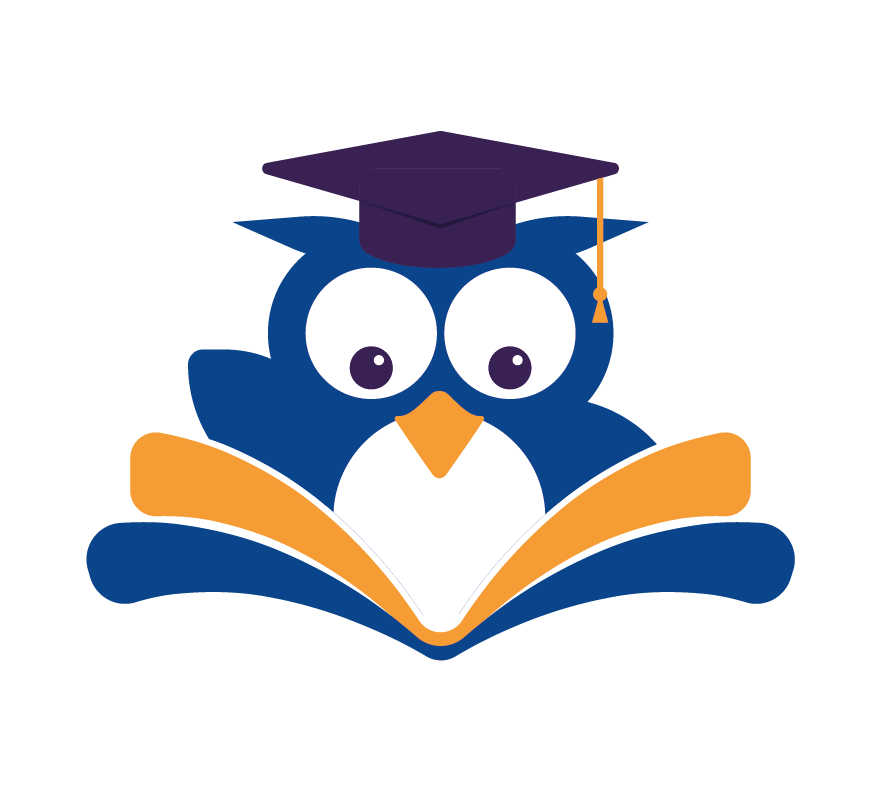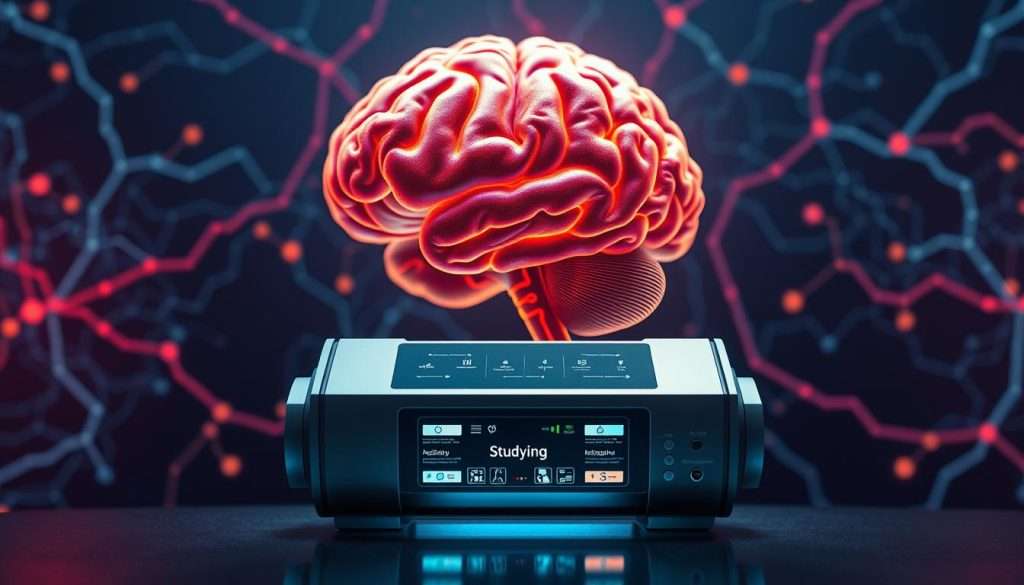We’re excited to explore the fascinating world of cognitive psychology and discover how our brains work! By understanding the intricacies of our brain, we can unlock our full potential. This makes studying an enjoyable experience.
In this article, we’ll delve into the latest research in brain-based learning and educational neuroscience. We’ll discover proven techniques to boost your brain power. We’ll show you how to make studying into an effective learning experience that you’ll look forward to.
Key Takeaways
- Discover the latest research in cognitive psychology and educational neuroscience.
- Learn proven techniques to boost your brain power.
- Transform studying into an enjoyable, effective learning experience.
- Unlock your full potential by understanding how your brain works.
- Make studying a fun and engaging experience.
Understanding How Your Brain Learns
Your brain is always changing and can do amazing things. As we dive into the brain’s details, we find out how to learn better.
The Neuroscience Behind Learning
The study of educational neuroscience has really advanced. It shows how our brains handle new info. Learning makes new neural pathways that help us keep new info.
Neural Pathways and Synaptic Connections
Think of your brain as a busy city of neurons. When you learn something new, like a guitar chord, neurons connect. These synaptic connections are key for learning and remembering.
Brain Plasticity and Lifelong Learning
The brain’s plasticity is really cool—it can change and adapt all life long. This means we can keep learning and getting better at new things, no matter our age. By using this plasticity, we can learn more effectively.
By using brain-based learning, we can make our study habits better. This way, we learn and remember more easily.
The Science of Learning: Key Principles and Research
Studying educational neuroscience has uncovered how we learn and keep information. Knowing how learning works helps us find better ways to learn and remember new things.
Foundational Studies in Educational Neuroscience
Many studies have changed how we see learning. Two key ideas from this research are Ebbinghaus’s Forgetting Curve and Cognitive Load Theory.
Ebbinghaus’s Forgetting Curve
Ebbinghaus’s Forgetting Curve shows that our memory drops fast without practice. Studies say we might forget up to 70% of new info in a week if we don’t review it. This shows how important it is to keep reviewing what we learn.
Cognitive Load Theory
Cognitive Load Theory says our working memory can only hold so much. When we learn something new, it’s key to break it down into smaller parts. This makes it easier to understand and remember.
Using these ideas can make learning better. For example, spaced repetition helps fight the forgetting curve. Also, being careful with how much we try to learn at once can help us remember more.
Knowing these studies can help you control your learning better. By using these science-backed methods in your studying, you’ll learn more and reach your goals faster.
Memory Formation and Retention Techniques
Learning how our brains make and keep memories is key for good learning. Memory creation is complex, involving many brain areas and paths.
How Memories Are Created in the Brain
Memories form through consolidation, turning short-term memory into long-term. This changes how neurons connect and strengthen.
Spaced Repetition: The Science of Not Forgetting
Spaced repetition fights the forgetting curve. Reviewing material at longer intervals boosts long-term memory and keeps it.
Creating an Effective Spaced Repetition Schedule
To make a good spaced repetition plan, first pick what you want to remember. Then, review it at the best times, making intervals longer each time.
Digital Tools for Implementing Spaced Repetition
Digital tools like flashcard apps help with spaced repetition. Apps like Anki and Quizlet use smart algorithms to set the best review times.
| Tool | Description | Platform |
|---|---|---|
| Anki | Flashcard app using spaced repetition | Web, iOS, Android |
| Quizlet | Study site with flashcard and spaced repetition features | Web, iOS, Android |
Understanding memory creation and using spaced repetition can greatly help you remember things better.
Optimizing Your Learning Environment
Creating the perfect learning environment is key to staying focused and productive. Your study area greatly affects how well you can concentrate and remember things.
Physical Space Design for Maximum Focus
A well-designed study space is essential for learning. It’s not just about looks; it’s about making a space that’s comfortable and distraction-free.
Ergonomics and Learning Efficiency
Ergonomics is crucial for learning well. A well-set up study area helps avoid fatigue and discomfort, letting you study longer. Use an ergonomic chair and place your computer monitor at eye level.
Minimizing Distractions in Your Study Space
To stay focused, it’s important to keep distractions away. Make a specific area for studying, free from clutter and interruptions. Natural sunlight and a cozy atmosphere can also boost creativity, as studies show.
| Element | Benefit | Tip |
|---|---|---|
| Natural Sunlight | Boosts mood and energy | Position your desk near a window |
| Ergonomic Furniture | Reduces physical discomfort | Invest in an ergonomic chair |
| Minimal Clutter | Improves focus | Regularly clean your study space |
Optimizing your learning environment can greatly improve your focus and learning. It’s about making a space that’s both comfortable and productive.
Effective Study Strategies Based on Cognitive Science
Cognitive science can make studying more effective and efficient. It offers strategies to improve how you learn and remember information.
Active Recall: Why Testing Yourself Works
Active recall is a key study technique. It involves recalling information from memory instead of just re-reading it. This method helps you remember better in the future.
Implementing Practice Tests in Your Study Routine
Practice tests are a great way to use active recall. Testing yourself on the material you’re learning can help you remember it better. You can make your own tests or find online quizzes.
- Create flashcards with key terms on one side and the definitions or explanations on the other.
- Test yourself by trying to recall the information on the back of the card without looking.
- Use online platforms or apps that offer pre-made flashcards or allow you to create your own.
Flashcards and Other Active Recall Tools
Flashcards are great for active recall. They can be physical or digital and help with memorizing key terms and concepts. Other tools include summarizing information in your own words and creating concept maps.
| Active Recall Method | Description | Benefits |
|---|---|---|
| Practice Tests | Testing yourself on the material you’re trying to learn. | Improves retention, identifies knowledge gaps. |
| Flashcards | Using cards with key terms on one side and definitions on the other. | Enhances memorization, portable study tool. |
| Summarization | Summarizing information in your own words. | Improves understanding, aids in retention. |
Using active recall techniques in your study routine can boost your learning. It’s helpful for exams, learning new skills, or improving memory. Active recall is a powerful tool in your educational toolkit.
The Power of Sleep and Exercise in Learning
Sleep is key for memory, and it’s more than just rest. It’s about good sleep habits. Our brain strengthens memories during sleep, moving them from short-term to long-term storage.

Sleep’s Critical Role in Memory Consolidation
Sleep is critical for memory. Our brain replays learned info during sleep, making connections stronger. This is vital for learning and remembering.
Optimal Sleep Patterns for Students
What’s the best sleep for students? Most adults need 7-9 hours each night. A consistent sleep schedule is essential, with regular times for bed and waking, even on weekends. Here are tips for students:
- Have a bedtime routine to tell your brain it’s time to sleep.
- Stay away from screens before bed.
- Make your room sleep-friendly, like cool and dark.
Napping Strategies for Learning Enhancement
Napping boosts learning. A short nap refreshes the brain, enhancing focus and productivity. Here are napping tips:
- Short naps, 15-20 minutes, are best for a quick boost.
- Nap early to avoid night sleep disruption.
- Regular napping helps set sleep patterns.
While sleep is vital, exercise also aids learning. Exercise improves brain function and memory. Combining good sleep with exercise maximizes learning potential.
Nutrition and Brain Health for Optimal Learning
Fueling your brain with the right nutrients is key for learning and thinking well. What you eat greatly affects your brain health and how well you learn and remember.
Brain-Boosting Foods and Nutrients
A balanced diet full of important nutrients is good for your brain. Let’s look at some key foods that help a lot.
Essential Fatty Acids and Brain Function
Omega-3 fatty acids, like EPA and DHA, are very important for your brain. They help your brain work better and can improve memory and thinking. You can find these in fatty fish like salmon, sardines, and mackerel, as well as in walnuts and chia seeds.
Antioxidants, Vitamins, and Minerals for Cognitive Health
Antioxidants, like vitamins C and E, protect your brain from damage. Foods high in antioxidants include berries, leafy greens, and nuts. Vitamins B6, B9, and B12 are also key for brain health, helping with thinking and nerve health. Minerals like magnesium and zinc are important too, supporting nerve function and learning.
To improve your brain health, add these nutrients to your diet:
- Fatty fish (salmon, sardines)
- Nuts and seeds (walnuts, chia seeds)
- Berries (blueberries, strawberries)
- Leafy greens (spinach, kale)
By choosing the right foods, you can greatly improve your brain’s performance and overall health.
Overcoming Learning Obstacles with Science-Backed Approaches
Cognitive load and information overload can block our learning. But, knowing how to handle them can change everything. Our brains work hard when we learn something new. They process info, make connections, and store memories.
Too much info at once can cause cognitive overload. This makes it tough to understand and remember what we’re learning.
Managing Cognitive Load and Information Overload
It’s key to manage cognitive load for effective learning. We need to know how much info our brains can handle. Recognizing the signs of cognitive overload is the first step. These signs include feeling confused, struggling to follow instructions, or feeling mentally tired.
Recognizing the Signs of Cognitive Overload
When we’re cognitively overloaded, we might:
- Feel mentally exhausted after studying
- Struggle to recall information
- Find it hard to focus
Knowing these signs helps us take action and change our learning strategy.
Techniques for Breaking Down Complex Information
Breaking down complex info into smaller chunks helps manage cognitive load. This can involve:
- Creating outlines or mind maps to organize information
- Using summaries or abstracts to get an overview before diving into details
- Breaking study sessions into shorter intervals with breaks in between
| Technique | Description | Benefit |
|---|---|---|
| Chunking | Breaking down information into smaller pieces | Reduces cognitive overload |
| Summarization | Creating a concise summary of the main points | Helps in quick review and recall |
| Spaced Learning | Studying in intervals with breaks | Improves retention and reduces burnout |
As Dr. Barbara Oakley, a renowned expert in learning, once said, “Learning is not just about making connections; it’s about making the right connections.”
“The key to effective learning is not just in the quantity of information, but in the quality of the connections we make between different pieces of information.”

By using these science-backed methods, we can beat common learning obstacles. This makes learning more efficient and fun.
Conclusion: Implementing Your Personalized Learning Strategy
We’ve looked into the science of learning. Now, it’s time to use what we’ve learned. Creating a personalized learning plan is key to success. By using the methods from this article, you can make a learning strategy that fits you.
First, figure out what you want to learn and how you study now. Think about how to make your learning environment better. Add effective study habits to your daily life. This will help you reach your learning goals.
Learning well means being consistent, persistent, and patient. Stick to your learning strategy and be ready to make changes. With effort, you’ll learn better and tackle new challenges with confidence.

